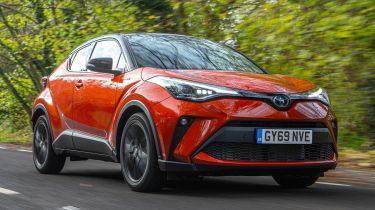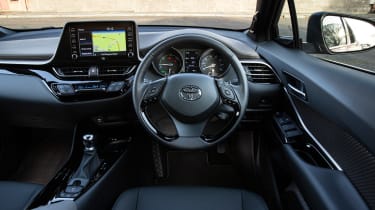Toyota C-HR (2016-2023) review - Interior, design and technology
Bold exterior styling and an upmarket interior help the C-HR shake off Toyota’s dowdy image

Toyota went bold with the design of the C-HR. Not only did its blend of coupe styling cues and jacked-up suspension help it stand out in this class, neat detailing also boosts its kerb appeal.
Heavily based on the C-HR concept that made its debut at the 2014 Paris Motor Show, the Toyota still stands out from the compact crossover crowd. In fact, apart from the adoption of a five-door layout, the production version looks remarkably similar to the show star.
Like upmarket machines such as the BMW X6 and Mercedes GLE Coupe, the C-HR features a low roofline that gives it the rakish profile of a coupe. This illusion is heightened by the fact the handles for the rear doors are hidden in the C-Pillars. Yet it's Toyota's daring combination of creases, curves and eye-catching angles that really grabs the attention.
All versions got alloy wheels and distinctive LED running lamps, while Excel models stand out at night courtesy of their bright LED headlamps and tail lights. The CH-R was offered with a number of optional paint colours, some of which came with a contrasting black finish for the roof panel.
2020 saw Toyota introduce the facelifted C-HR and on the outside it was distinguished by reshaped LED headlights, a new front grille and a smoothed-over front bumper with new air intakes and fog lamps. There was also a new rear diffuser with extra chrome details and a revised pair of LED tail lights, which fared into a new gloss black lip spoiler.
The C-HR maintained its premium appeal inside too. The wraparound dashboard places the driver firmly at the centre of the action, while multiple shapes and textures give the interior a funky look. Neat details include the diamond pattern that’s repeated in the door trim, headlining, multi-function wheel buttons and climate controls.
Toyota has given the interior a lift courtesy of some coloured accents, while the Excel model includes a smart dark brown upper dashboard. However, it’s the quality of the cabin that really grabs your attention. Soft touch plastics are used throughout, while gloss black inserts add a touch of class. As you’d expect from Toyota, everything is solidly screwed together.
Toyota didn’t scrimp on the standard kit, either. All versions get climate and adaptive cruise control, automatic lights and wipers, an auto dimming rear view mirror and eight-inch touchscreen infotainment system. The Design trim features keyless entry, heated seats, parking assist and power folding mirrors, while Excel versions include luxuries such as a heated steering wheel and black leather upholstery.
Sat-nav, stereo and infotainment
Toyota updated the infotainment system in 2019 – with the Touch 2 media system featuring Apple CarPlay and Android Auto connectivity as standard. This makes a big difference, because it allows owners to bypass Toyota’s otherwise fiddly infotainment set-up, which is hindered further by the dated graphics and a poor layout.
In addition, all cars include Bluetooth, a DAB radio, a 4.2-inch TFT driver information display and a reversing camera.











